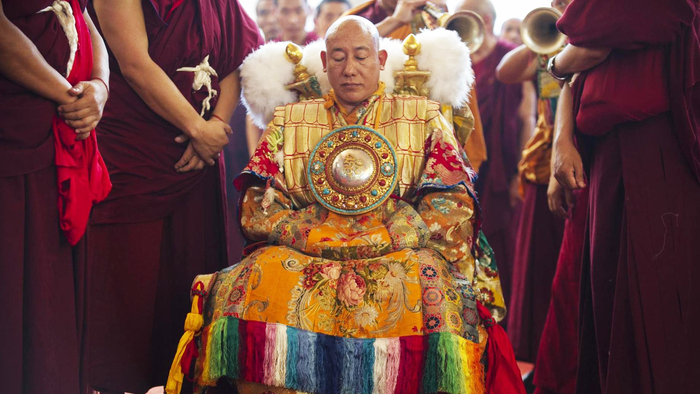
In the shadow of the majestic Himalayas, where the thin air is infused with the scent of incense and the distant echo of prayer wheels turning, lies Dharamsala – a sanctuary for seekers of ancient Buddhist wisdom. It is here, amidst the tranquil beauty of this hill town, the home of His Holiness the Dalai Lama and thousands of Tibetan refugees, that we find ourselves on a quest to unravel the mysteries of the ancient practice of oracular divination, guided by none other than Venerable Thupten Ngodup, revered across the Tibetan Buddhist world as the enigmatic "Nechung Oracle."
Our journey leads us to the precincts of Nechung Monastery, where, amidst the fluttering prayer flags and the melodious chanting of monks, we are granted an audience with Venerable Ngodup. Born in Tibet in 1958, he entered into his first spontaneous trance in 1987, during the annual offering ceremony to the protector Pehar, at Nechung Monastery. It was this moment that changed the path of his life forever. Since then, he has served His Holiness the Dalai Lama and the Tibetan Government-in-Exile as the official state oracle.
Our conversation with Venerable Thupten Ngodup delves deep into the significance of Dharma protectors on the path enlightenment. We also look at what they actually are, and why so many of them take on such wrathful aspects. With intense curiosity, we also ask Venerable Ngodup to share his experiences of entering into trance, and to describe any preparations he needs to undertake before he is ready to become a medium between the natural world and spiritual plane. Finally, as our conversation unfolds, a fundamental question emerges – do Buddhist practitioners truly need to rely on Dharma protectors on their spiritual journey? Find out by enjoying the entire interview below!
Study Buddhism: What are Dharma protectors, and in particular, what are the Nechung Dharma protectors?
Venerable Thupten Ngodup: Dharma protectors are not found in all Buddhist traditions; but they have a connection with tantra and the tantric Tibetan Buddhist traditions. Dharma protectors and guardians of the Dharma appear as lamas, Buddhas, bodhisattvas, viras, and dakinis in Vajrayana, the Mahayana tantra tradition. Among them, there is one class of Dharma protectors who take possession of mediums who channel them – such as the Nechung Dharma protector, channeling through the “Nechung Oracle.”
The Nechung Dharma protectors are manifestations of the Five Triumphant Buddha-Families. In the eyes of ordinary disciples, they channel through mediums as the Dharma guardians known as the Five Bodily Manifest Kings (Gyalpo Kunga). Amongst these worldly deities, the Five Bodily Manifest Kings, the one known as Dorje Drakden is these Five Bodily Manifestations incorporated into one, manifesting through the Nechung Oracle. Dorje Drakden appears to ordinary disciples in the form of a worldly god, a wisdom-holder.
How does one become a medium in the Tibetan tradition?
In Tibetan Buddhism there have been several mediums that channel worldly deities. One type of medium passes through a family lineage – for example, Gadong, Tshangpa, and Tenma. In these cases of male deities, if the father was the medium, his son becomes the medium, following in line from a family lineage. For female deities, if the mother was the medium, such as with the medium of Tenma in Tibet, then her daughters become mediums one after another. Even in cases among our lamas, like with the Sakya Throne Holders, there is no need to search for their reincarnations. Their successors follow from a family lineage of descendants.
But it is different in the case of the Nechung Dharma protector. The protector himself selects the person, but in some cases, mediums have been recognized by highly realized lamas. Then, following a thorough examination by His Holiness the Dalai Lama, the medium for the Nechung Dharma protector is appointed.
What events led to your selection as the current medium of the Nechung Dharma protector?
In 1984, the previous medium for the Nechung Dharma protector, Venerable Lobsang Jigme, passed away. Following his passing, there was no medium for a few years.
There is a strong, unique relation between Nechung Monastery and its root monastery, Drepung. In Tibet, as Drepung and Nechung Monasteries were very near each other, the entire assembly of lamas, monks and abbots of Drepung would go every month to Nechung on a day called “the day of the protector deity of Drepung.” There, they would invoke the Dharma protector.
However, since our exile to India in 1959, Drepung Monastery was re-established in South India, while Nechung Monastery was established in North India, so invoking the protector does not take place every month like in Tibet. Instead, there is a custom that the entire monastic assembly presents ceremonial scarves in front of the thangka painting of Nechung in the protector room at Drepung Monastery, and they recite the text for fulfilling and restoring the commitments to the protector, requesting his activities.
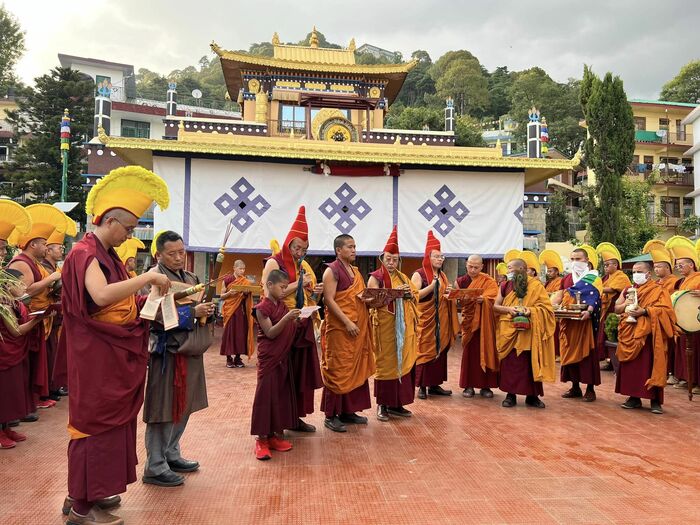
Every year when His Holiness gives his spring teachings in Dharamsala, many members of the monastic community from Drepung attend. On that occasion, they invoke the Dharma protector. Sometimes, on the occasions when His Holiness comes to South India, they also invite the Dharma protector to appear. After the passing of the previous Nechung Oracle, the invocations did not take place for three years.
In 1987, His Holiness gave a teaching on A Grand Presentation of the Graded Stages of the Path, Lam-rim chen-mo, in Dharamsala. On that occasion, many lamas and geshes came from Drepung. The second day of the second Tibetan month, the Day of the Protector Deity, fell during that period. On that day, they all came down here to Nechung Monastery, where the physical bases for the protector are contained.
At that time, I was serving as the ritual attendant. Just when the lamas and abbots invoked him, all of a sudden, the Dharma protector entered into me. It was like a flash of lightening had occurred.
So, it was in 1987 when their Dharma protector spontaneous entered you for the first time. What happened after this? Were there any special rituals to install you as the official state oracle?
After the protector first entered into and took possession of me, I requested an audience with His Holiness the Dalai Lama. He asked me if I was willing to have the Nechung Dharma protector enter into and channel through me. I said that if I were able to be of service to the religious and secular government of Tibet and to His Holiness, then yes.
His Holiness told me I needed to do a retreat of the deity Hayagriva. I was in retreat for three months at the Nechung monastery. During that period, every ten days, Khamtrul Rinpoche would come to see me. Occasionally, he would send Denma Locho Rinpoche to visit me, then they would report back to His Holiness.
After that, the oracle was invoked several times. One day, he was invoked in the presence of His Holiness and later he was invoked in public. On the 4 September 1987, I had a new audience with His Holiness as the medium of the Nechung Dharma protector and an official ceremony was held to install me in connection with the government.
Were there ever any signs that you might be a suitable individual to become a medium?
There were several signs. One of those prior signs occurred in 1985 when His Holiness conferred the Kalachakra initiation in Bodh Gaya. The Kalachakra initiation was organized by the Department of Religion and Culture of the Central Tibetan Administration. The Monlam Prayer Festival was also convened there. There are eight auspicious symbols and eight auspicious substances connected with the Monlam Prayer Festival, known as “the offering substances of Chenrezig Gyalwa Gyatso,” and small pictures of them needed to be painted, but the organizers forgot to bring them. Garje Khamtrul Rinpoche, the secretary of the Department of Religion and Culture, asked me to paint them. Having accepted the responsibility to paint them, I went to the bazaar to buy the paints and the entire task took the whole day. I was really exhausted that day.
The next day, I woke up early and, when I started my work, I developed a severe nosebleed. It bled and bled. My nose kept bleeding for almost three days without interruption. After a while, I couldn’t even stand up. During that time while my nose was bleeding, I sat in a tent with my neck bent back like this. From where I was sitting, however, I could directly see the Mahabodhi Stupa; but what appeared uniquely to me was a vision of the Dharma protector coming and entering into me. It happened like that. Afterwards, the nosebleed was taken as a sign of the dredging out and then cleansing of my subtle channels. After that, I also had a vision of the former medium.
What kind of preparation, if any, do you have to undertake in order for the deity to enter into you?
If there is to be an invocation of the Dharma protector – which can be a private invocation for His Holiness or for a division for one of the monasteries – they send me a message two or three days beforehand saying there is to be an invocation.
On the morning of the invocation, the monks at Nechung Monastery who will perform the invocation ceremony assemble for reciting the self-generation sadhana, and then they perform the rituals of self-generation. That morning, I myself recite, in full, the self-generation of the yidam Buddha-figure and the requests for his activities. Then I go over to the assembly hall. After taking off my monk’s robes, the attendants dress me in the attire of the Dharma protector. After that, I sit on the throne in the place where the invocation is to take place while the monks chant.
Once you’re sitting on the throne – and people can see this in videos of you going into trance – you seem to start shaking and your lips start moving. Are you aware at all of the deity entering you?
Well, this is something strange; sometimes, it is like a dream. For example, if you had a dream last night, it is not clear in the morning. You recall that you did have a dream, but you don’t remember it.
Have you ever had any difficulties going into trance? And when it does happen, are there any physical effects? What does it feel like when you come out of the trance?
A lot depends on the individual group that has requested the invocation, whether it’s the Kashag (the cabinet) or a division of one of the monasteries. There are individual differences in terms of who has requested it, and sometimes I have a lot of difficulties, while other times, I don’t have any difficulties at all.
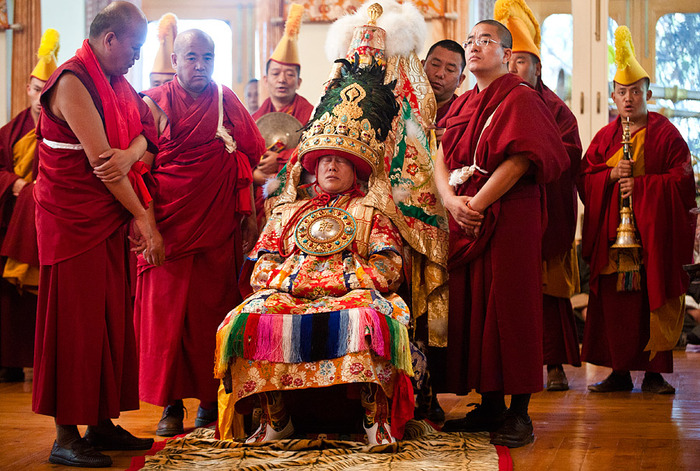
One strange thing is that before there is to be an invocation, a lot of fear and anxiety come to my mind. Then, right when they are invoking him, the monks are chanting, blowing the conch shell, and playing the gyaling oboe, I get really terrified. The feeling that comes to me right before an invocation is the feeling you have when you are in an airplane and the weather is bad, and the plane keeps bumping up and down.
While that is happening, I still see the people in front of me, then they get more and more distant. After some time, my ears no longer apprehend the sound of the conch and gyaling oboe that I had been hearing. You know when you’re completely exhausted and you fall asleep? It’s like falling asleep after being exhausted like that.
Usually when we fall asleep after being exhausted, in our minds we think we have been sleeping for just five minutes, but we’ve in fact, been asleep for half an hour. Whether the invocation of the Dharma protector lasts an hour – sometimes it’s more, sometimes it’s less – to me, it’s something like having been asleep for five minutes, although at that time, the invocation had been going on and on.
As the people in front of me slowly become less and less clear, my breath becomes faster and my heart beats more strongly. My hands go numb; my feet, too, go numb, and then my whole body goes numb. It’s like after we’ve been sitting cross-legged for a long time, and we lose all feeling in our legs. There is a feeling inside me of becoming large and heavy. My chest becomes tight. Then I feel something like a flash of lightening, a sudden flash of something red. After that, I lose consciousness. It is like falling asleep.
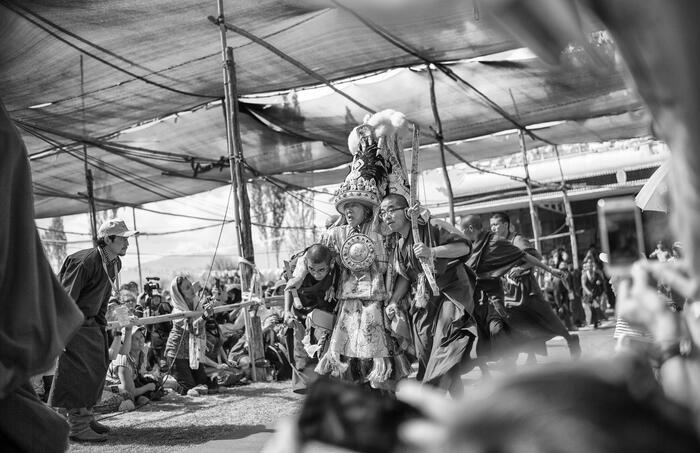
Once the deity has departed from me, they carry me from the assembly hall to the protector room next to it and dress me in my monk’s robes. When I regain consciousness, it is a bit like waking up. At that time, my limbs are all still numb and all my subtle channels are still numb. Then, they rub them a little for five or ten minutes and, after that, they become like they are normally. After that, for about twenty minutes, my mind becomes very calm, and a special feeling of great bliss comes on. Sometimes I think there is no one happier than me in the whole world – it’s that kind of feeling that comes on. I don’t know if it’s some inspirational uplifting from the protector or what it is. But sometimes, my head really aches. I get a pain in both my head and chest.
You also need to wear this very specific hat and special robes for the rituals. I’ve read that the hat is so heavy that when one isn’t in trance, it would be nearly impossible to wear it and dance around, as you do. Can you tell us more about this hat?
The hat is called the “helmet of the Dharma protector.” The whole attire including the robe was created by Desi Sangye Gyatso after the time of the Great Fifth Dalai Lama and offered to the Dharma protector in the manner of an offering of thanksgiving. They are considered something very precious. Originally, they were first the robes and attire of the Nechung Dharma protector.
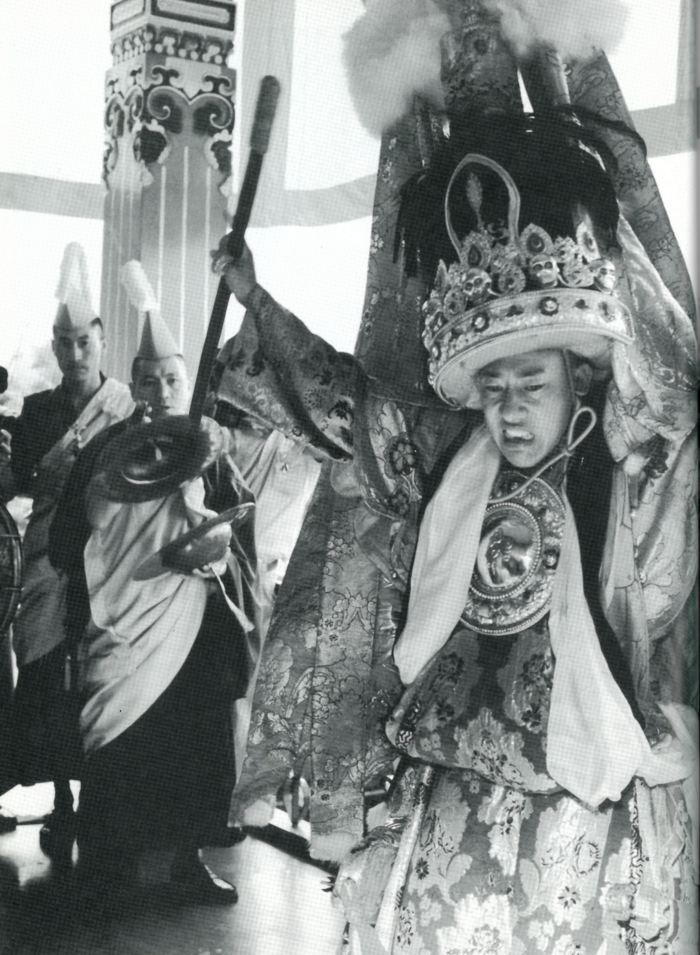
The hat used in Tibet was really heavy since it had a great deal of gold on it. Here in India, the hat alone is not more than fifteen kilos. However, the whole attire is 42 kilos.
If I were to wear the hat before the protector deity first entered me, I couldn’t carry the weight. But once the deity enters me, I do not notice the weight.
It is said that Padmasambhava, the revered Indian tantric master also known as Guru Rinpoche, subdued the local guardian spirit, Pehar Gyalpo. This guardian subsequently became known as Dorje Drakden. Can you tell us more about the history involved?
The earlier spread of Buddhism in Tibet began during the eighth century. At that time, King Trisong Detsen invited the Great Abbot Shantarakshita from India. Soon after, they began constructing Samye Monastery, but many local gods and harmful spirits created interferences. Therefore, the Great Abbot Shantarakshita invited Guru Rinpoche to counter these negative interferences. Thus, Guru Rinpoche Padmasambhava tamed and bound to oaths all the local gods and venomous harmful spirits.
After the infrastructure and resident monks had been established at Samye Monastery, they consulted about the need to have protectors, and Guru Rinpoche said, “Tibet is the land of beings to be tamed by Arya Avalokiteshvara. The protector that has a connection with Avalokiteshvara is the King Pehar, known as White Namtig, a worldly deity of the Orkhon Uighur Turks.”
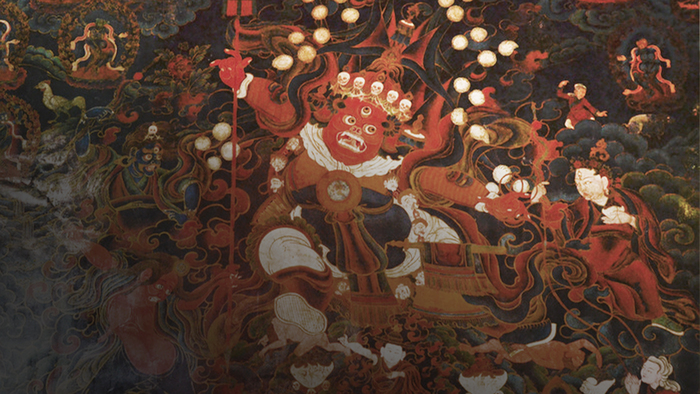
In those days, Dorje Drakden was not known as the Nechung Dharma protector. He was called King Pehar, from the land of the Bhata Hor (the Orkhon Uighur Turks).” When we look at present-day maps for the territory of the Orkhon Uighur Turks, we see it lies in Outer Mongolia. Guru Rinpoche said, “If he were to be invited and drawn to come here, he would be of help in safeguarding the teachings.”
The Dharma King Trisong Detsen’s son, Muni Tsenpo, was given specific responsibilities to invite and draw back King Pehar to Tibet and install at Samye Monastery the many special physical bases for summoning the Dharma protector. Once that was done, the Dharma protector (King Pehar) came on his own accord. The Dharma protector then swore to abide by Guru Rinpoche’s order and promised to safeguard the teachings.
You mentioned that King Pehar was thought to be from an area located in present-day Mongolia. Is there still any connection between Mongolia and Pehar and the Nechung Oracle?
The Dharma protector was first invited from Mongolia. It is what we call “the land of the Bhata Hor (the Orkhon Uighurs) of Mongolia.” The Mongolians themselves call it “Bata Khordar,” which is in the province Zavkhan Aimag, (Otgon district). The physical bases for the Dharma protector had been located at the sacred mountain of Vajrapani, called Otgontenger. In its vicinity is a sacred divinatory lake named Khökh Nuur. People say this was Bata Khor. This is why the Dharma protector is called “the worldly deity of Hor, White Namtig.” Therefore, the Nechung Dharma protector has been recognized many centuries ago as a worldly deity of the Mongols.
There are accounts of mediums in Mongolia channeling the Nechung Dharma protector in the past. But in recent times, after Mongolia’s government became communist, all of that was completely abolished and no longer exists. However, the palace where the mediums resided and their ritual items have been preserved and can be seen these days in a museum.
Because of this connection, the Great Fifth Dalai Lama and the Thirteenth Dalai Lama travelled to Mongolia. I myself was able to visit Mongolia after 1990, and my personal relationship with the Mongols began then. In 2008 and 2009, I investigated the original sacred site of the Nechung Dharma protector in Mongolia. It was very far away from the capital, Ulaanbaatar. You need to fly for two and a half hours, then drive for eight or nine hours, and then after that, hike to reach it. The conclusion of my investigation was reported to His Holiness the Dalai Lama, who told me that it would be good to erect a shrine for sacred objects at this sacred site.
I had a two-story shrine built, with a statue of Vajrapani installed in the upper story. In the lower story, I had a statue of the King of Enlightening Influence (Pehar), the principal one of the Five Bodily Manifest Kings, installed.
Since the Mongols themselves have considered this site as a sacred site for centuries, there is the custom that when a new president of Mongolia is elected, they go there and offer the smoke of burning juniper branches and make requests to the protector. Even nowadays, this custom is followed exactly like that.
Due to this connection, I am repeatedly asked to go to Mongolia.
It seems that most Dharma protectors are very fierce looking – to the point of actually being quite scary in some cases. And in many Tibetan temples, the protector chapels are usually very dark and frightening. Why is it that Dharma protectors take on this wrathful aspect?
The arising of what we call “fierce aspects” of Dharma protectors takes place when deteriorations have emerged in this world. When the mediums enter and channel in the aspects of Buddhas and bodhisattvas, it is like when parents raise their children with love and when they discipline them, the children listen. But with some children, when the parents discipline gently, it doesn’t help, so they need to do this in a forceful manner. It is not that their inner motivation for being forceful is based on not having loving affection for their children. When the parents yell and scold them, this is for the sake of benefiting them and not for the sake of harming them.
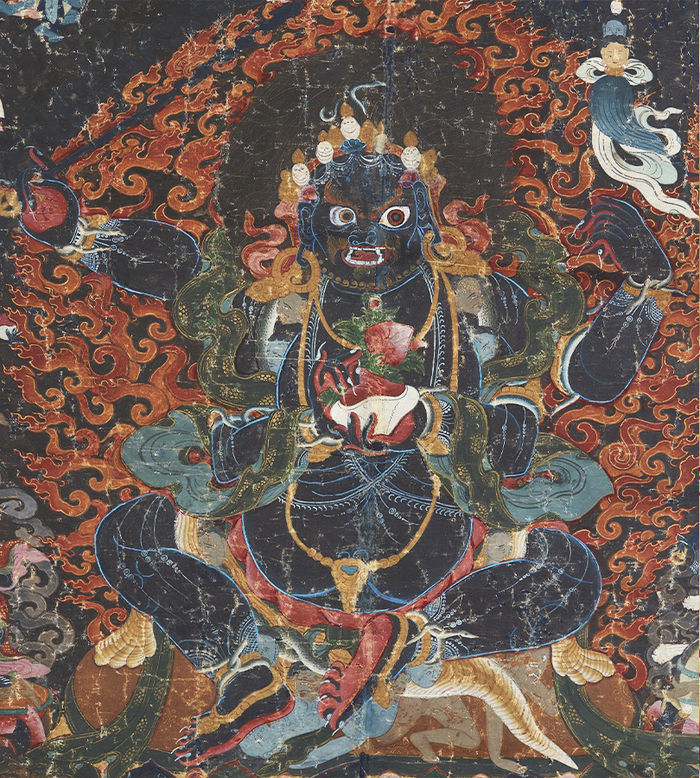
Similarly, as for the arising of Dharma protectors and guardians in forceful aspects, it is said that their arising in forceful aspects is for taming those sentient beings who cannot be tamed by peaceful aspects. However, among Dharma protectors, there are also some that are peaceful and not forceful.
How is it that Nechung came to be the State Oracle to the Tibetans? What kind of relation is there with His Holiness the Dalai Lama and the Tibetan government?
The Nechung Dharma protector as the principal worldly deity is relied on by the government to counter enemies, therefore it is called the “Principal State Oracle.” This is something that relates to the lineage of our Triumphant Ones, the Dalai Lamas. The relationship has come about from the Second Dalai Lama onwards, down through successive incarnations. Under the Great Fifth Dalai Lama, who established the Ganden Phodrang government of Tibet, Nechung was appointed as the state oracle, the principal worldly deity relied on by the government to counter enemies. From then on, up to the present 14th Dalai Lama, this tradition has continued. When His Holiness conducts both spiritual and political matters, he consults the Dharma protector jointly on behalf of the current Government-in-Exile and the Dalai Lamas’ institution, the Ganden Phodrang.
In 2011, however, His Holiness the Dalai Lama relinquished his responsibility as Tibet’s political leader and now engages only in spiritual matters. But he still maintains his relationship with the Dharma protector in the name of the Ganden Phodrang. Nowadays, in our Tibetan Government-in-Exile, we elect a Sikyong, a Prime Minister. The Sikyong invokes the Dharma protector regularly, twice a year, thus continuing to maintain the relationship.
Finally, for students of the Dharma, is it necessary to engage in Dharma protector practices?
No, there is no need for that. Whether you are a foreigner or you are a Tibetan, studying the Dharma does not require reliance on or engagement with Dharma protectors. The main thing is training in the Buddhist view and conduct, and studying the Buddhist classic texts. When we talk about relying on guardian Dharma protectors, these are beings that can assist with our path. They can help and have influence in averting obstacles. When, in Sanskrit, Dharma protectors are called “Dharmapala,” protectors of the Dharma, it means they are beings that protect practitioners of the Dharma. For individuals who practice in accord with the pure Dharma and karmic cause and effect, there is no need to rely on Dharma protectors.
Dear Venerable Thupten Ngodup, thank you so much for sharing your incredibly unique experience as a medium as well as your vast knowledge of the Dharma!